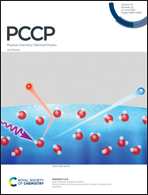First-order hyperpolarizabilities of propellanes: elucidating structure–property relationships†
Abstract
Following recent experimental work demonstrating strong nonlinear optical properties, namely second harmonic generation of light, in crystals composed of 16,20-dinitro-(3,4,8,9)-dibenzo-2,7-dioxa-5,10-diaza[4.4.4]propellane molecules [A. Miniewicz, S. Bartkiewicz, E. Wojaczyńska, T. Galica, R. Zaleśny and R. Jakubas, J. Mater. Chem. C, 2019, 7, 1255–1262] in this paper we aim to investigate “structure–property” relationships for a series of 16 propellanes presenting a wide palette of substituents with varying electron-accepting/donating capabilities. To that end, we use electronic- and vibrational-structure theories and a recently developed generalized few-state model combined with a range-separated CAM-B3LYP functional to analyze electronic and vibrational contributions to the first hyperpolarizability for the whole series of molecules. The variations in computed properties are large among the studied set of substituents and can reach an order of magnitude. It has been demonstrated that the maximum values of frequency-independent first hyperpolarizability are expected for strong electron-accepting NO2 substituents, but only at the preferred position with respect to the electronegative oxygen atom in the 1,4-oxazine moiety. This holds for electronic as well as vibrational counterparts.

- This article is part of the themed collection: 2022 PCCP HOT Articles


 Please wait while we load your content...
Please wait while we load your content...